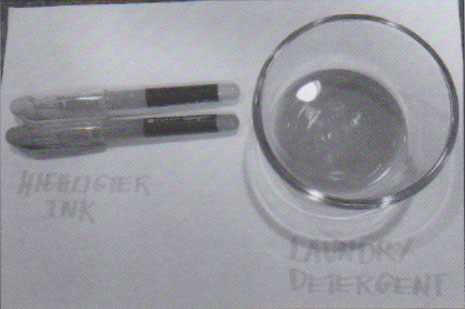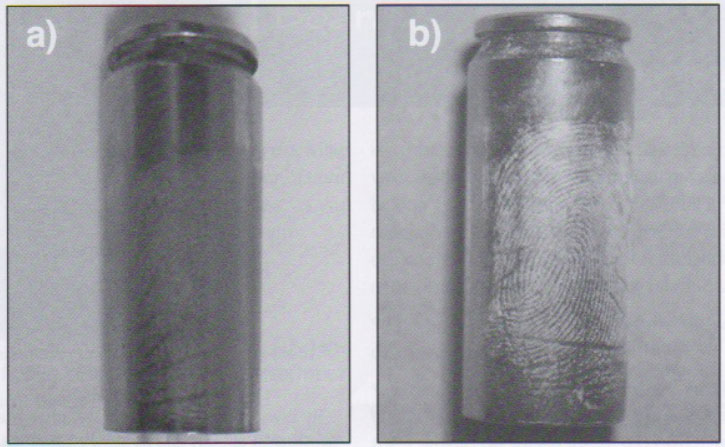Developing Latent Fingerprints using Colored Superglue
Roberto Alfaro
See also the instructional videos on "Locating and Collecting Fingerprints"
The premise of this experiment was to determine how to acquire a colored latent fingerprint through fuming to see if adding color to super glue would enhance the visibility and definition of friction ridges on latent fingerprints. Colored prints are easier to observe and have a greater potential to glow using an alternate light source (ALS). The colored agents that will be investigated are highlighter ink, vitamin B, and laundry detergent. These methods were tested on non-porous surfaces or porous items with a glossy finish.
Materials and Methods
- 12 Firearm cartridges (Four sets of 3)
- Highlighter ink
- Vitamin B powder capsule
- Laundry detergent
- Alternate light source (with orange filter)
- Superglue
- Superglue fuming chamber
Fingerprints were placed on all cartridge casings after being fired and discharged.
The first set of fired ammunition casings used the highlighter ink mixed with superglue. The second set four fired casings were treated with vitamin B, from a dietary capsule. These cartridges were superglue fumed and then dusted using the vitamin B powder. The third set used laundry detergent. The last set of casings served as the control and were superglue fumed only.
Each set of fired ammunition casings were processed separately according to the mixed substance. Cartridge casings were placed on the base of the fuming chamber containing the cup warmer with weigh boat, warm water and mixed substance.
Each set of experiments used three drops of mixed substance and five drops of superglue. Items were hung for 8·10 minutes to produce a better result. All 12 casings were processed through ALSs. Results were compared to the ridge quality grading system, as described in Figure 1.
5 — Very Good Visibility: Clearly defined friction ridges across entire point. Classifiable as one of the three basic fingerprint patterns (arch, loop or whorl). Core (center point) and minutiae (individual features, e.g. bifurcation, ending ridge) are visible. |
4 — Good visibility: Clearly defined friction ridges are visible across the majority of print. Classifiable as one of the three basic fingerprint patterns (arch, loop or whorl). |
3 — Poor visibility: Friction ridges are only visible on portion of print. The print cannot be classified into one of the three basic fingerprint patterns. Print may be smudged. |
2 — Bad visibility: No friction ridges are visible. Print is almost completely smudged or obscured and cannot be classified into one of three basic fingerprint patterns. |
1 — Blur/No Print: No print visible or only the outline of print is visible. |
the quality of the fingerprints developed from each technique.
Results and Discussion
The majority of the casings produced four levels of ridge detail: very few, some, good, and excellent. The casings processed with superglue and highlighter ink produced an excellent print, however the prints were not enhanced through the ALS. The cartridge casings processed with superglue and laundry detergent did not produce quality prints because the liquid was too thick to mix with superglue and, therefore, did not enhance prints through the ALS.

Figure 2: Examples of the substances that mixed with the superglue with
the intention of producing a colored fingerprint, but failed to effectively do so.
Conclusion
In general, the colored superglue produced a clearer result and enhanced the visibility of the minutiae points found on the print. After the casings were processed with superglue mixed with vitamin B, they were dusted with the vitamin B powder, which produced the best friction ridge detail. In addition to enhanced visibility of latent fingerprints through the ALS.

Figure 3: Image "a" depicts the cartridge casing treated with vitamin B
after being superglue fumed under ambient lighting. Image "b"
illustrates the developed fingerprint under alternate light sources.
Note for future latent fingerprint examinations
Vitamin B is environmentally safe and does not require protective equipment while processing evidence. In the case where fluorescent powder is not available during evidence collection and processing, vitamin B is inexpensive and available in most convenience stores without delaying the process of acquiring latent fingerprints.
For more information about the research conducted in this technical note, please contact:
Roberto Alfaro
jsralfaro@gmail.com
George Mason University
About this research article
This research project was done during the author's Master in Forensic Science program at George Mason University Fairfax, VA. He presented this research to Chesapeake Bay Division of IAI and to Young Forensic Scientist forum during the AAFS conference in Seattle, Washington in February 2014.
 Developing Latent Fingerprints using Colored Superglue Copyright: © 2013 by Roberto Alfaro. Copyright for this article is retained by the author, with publication rights granted to the Crime Scene Investigation Network. This is an Open Access article distributed under the terms of the Creative Commons Attribution-NonCommercial-NoDerivatives 4.0 International License which permits
unrestricted noncommercial use, distribution, and reproduction, provided the original work is properly cited and not changed in any way.
Developing Latent Fingerprints using Colored Superglue Copyright: © 2013 by Roberto Alfaro. Copyright for this article is retained by the author, with publication rights granted to the Crime Scene Investigation Network. This is an Open Access article distributed under the terms of the Creative Commons Attribution-NonCommercial-NoDerivatives 4.0 International License which permits
unrestricted noncommercial use, distribution, and reproduction, provided the original work is properly cited and not changed in any way.
Article submitted by the Author
Article posted: March 31, 2016

